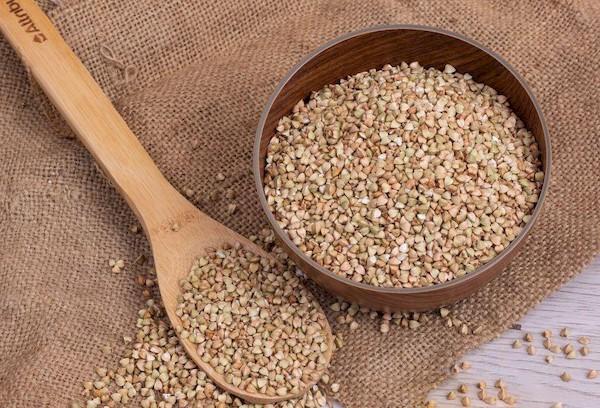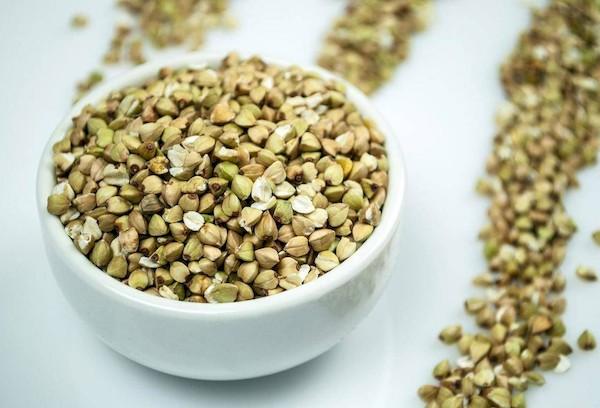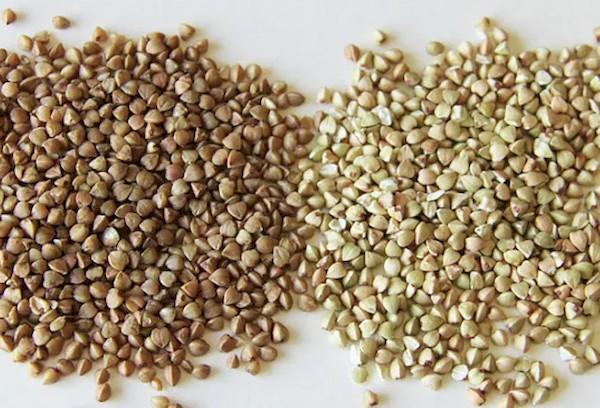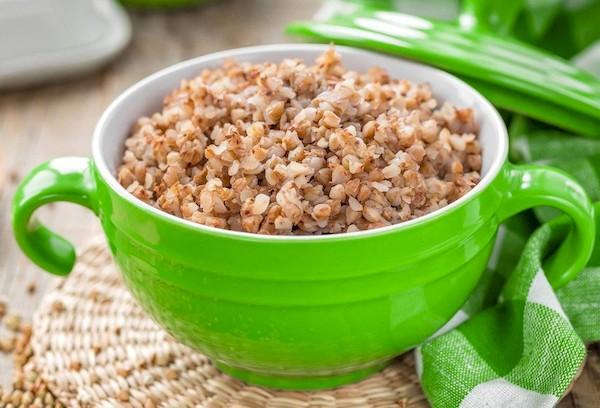What is the difference between green and regular buckwheat - what does it taste like and what is it used for?
Buckwheat is an integral part of Russian cuisine. Many people are used to buying dark, golden brown grains, and want to know how green buckwheat differs from regular buckwheat. The difference between them lies in the processing method. Green or light buckwheat, not fried, unheated. It has a natural color, less pronounced taste and a shorter shelf life. Adherents of a healthy lifestyle, as well as raw foodists, consider it more useful, since it contains a living embryo inside.
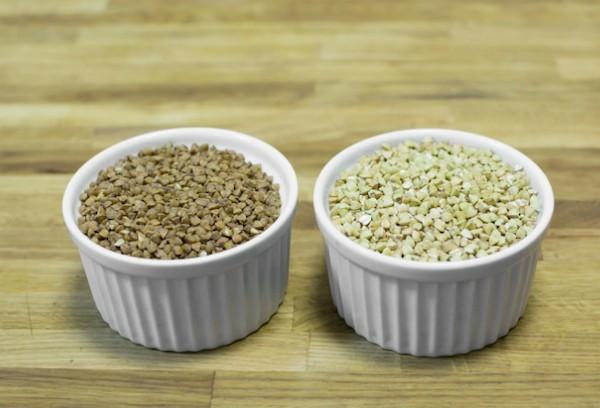
How to distinguish green buckwheat from regular buckwheat?
The difference between green buckwheat and regular buckwheat is noticeable to the naked eye. Cereals differ in appearance. Photo:
Green buckwheat is light, and regular buckwheat is dark.
All differences in the table:
| Green buckwheat | Regular buckwheat | |
| Trade marks | Mistral, Lifestyle, Green Line, Uvelka, Dynasty of Taste, Agro-Alliance and others | Mistral, Buckwheat, Fine Life, Don Gusto, MAKFA, National, Crossroads, Melkrup, Simply ABC, Uvelka, Pure Krupa, Shebekinskaya, Goodwill, Fair, GLOBUS, 365 days and others |
| Price | from 90 rub. for 300 g | From 90 rub. for 700 g |
| Color | from cream to yellow and green | all shades of brown |
| Taste and aroma | fresh, tender, herbaceous and nutty | nutty, rich |
| Consistency after cooking | juicy | dry |
| Cooking time | 15-20 minutes | 25 minutes |
| Calorie content | 330 kcal | 310 kcal |
| BJU | proteins – 13 g
fats – 3 g carbohydrates – 62 g |
proteins – 12 g
fats – 3.4 g carbohydrates – 57 g |
| Nutrients (% daily value per 100 g of cereal) | B1 – 26.7%
B2 – 11% B6 – 20% E – 44.7% RR – 21% potassium – 15% silicon – 270% magnesium – 50% phosphorus – 37% iron – 37% cobalt – 31% manganese – 78% copper – 64% molybdenum – 49% zinc – 17% |
B1 – 28.7%
B2 – 11% B4 – 10.8% B6 – 20% N – 20% RR – 36% potassium – 15% silicon – 270% magnesium – 50% phosphorus – 37% iron – 37% cobalt – 31% manganese – 78% copper – 64% molybdenum – 49% selenium – 10.4% zinc – 17% |
| Kinds | peeled (kernel) and unpeeled (seed) | processed unparboiled and parboiled - small and chopped kernels spoiled during transportation;
kernel - whole grains, peeled from fruit shells; fast-cooking (steamed) – treated with steam under pressure for 10-15 minutes |
| Application | side dish, soup, sprouts and microgreens, yogurts, smoothies, pancakes, salads | side dish, soup, cutlets, merchant-style buckwheat |
| Shelf life | 12 months | kernel – up to 15 months
completed - up to 18 months |
Both green and regular buckwheat can also be of the highest, 1st, 2nd and 3rd grade. According to GOST R 55290-2012, premium buckwheat must contain more than 99.35% of high-quality kernels. For other varieties, the percentage is lower - from 98.9%, 98.5% and 97.2%, respectively.
What is green buckwheat?
Green buckwheat is not a special type of grain. This is the same familiar and “ordinary” buckwheat, only thermally unprocessed.
The grain is obtained from the buckwheat plant, which has been cultivated for more than 5 thousand years. Buckwheat is native to southern China. In Russia they began to grow it much later, but it was in Russian cuisine that it took pride of place. It is believed that the grain was brought by the Greeks, hence the names - buckwheat, buckwheat, buckwheat (from the dictionary of M. Vasmer).
Cereals gained particular popularity during the Great Patriotic War.It is light, cooks quickly, rarely spoils, and is well suited for camping conditions. Thanks to its bright taste, the cereal could be cooked in plain water without salt, sugar, milk and butter, which were in short supply at that time. At the same time, the porridge still turned out delicious.
| pros | Minuses |
| High rutin content | Shorter shelf life |
| Contains more nutrients | Taste is for everyone |
| Can be germinated | Easily boiled |
| Can be fried | Not sold in all stores |
| Can be steamed | Price |
| Suitable for raw food diet |
Rutin gives buckwheat that same greenish tint. It is a powerful antioxidant, improves blood transport through blood vessels, strengthens capillary walls and reduces their permeability. The “guardian” of rutin is the husk - it contains 17 times more elements compared to the core.
The greener the buckwheat, the more routine it contains.
When cooked, the grain turns brown and the rutin is destroyed. In addition, storage in light contributes to the destruction of the useful element. This makes the buckwheat lighter and barely yellow.
What is “regular” buckwheat?
“Regular” buckwheat is brown in color. It acquires its usual color and taste after special heat treatment.
After harvesting, the grain is cleaned of husks using special hulling machines. Then it is sorted by grade and thermally treated. Typically, buckwheat is subjected to hydrothermal treatment at a temperature of 170-200 degrees. Simply put, the cereal is steamed for 5 minutes and then kept in a thermostat for about an hour. Previously, instead of the hydrothermal method, hot air drying (roasting) was used.
Heat treatment allows you to destroy microorganisms on the grain. “Regular” buckwheat is stored better and longer than green buckwheat.
| pros | Minuses |
| Retains its shape well and remains crumbly after cooking. | Comes with a burnt taste (rarely) |
| Long shelf life | |
| Useful product | |
| Easy to find on sale |
Question answer
Why is green buckwheat harmful?
Harm from green buckwheat is possible when consuming the cereal in its raw (sprouted, steamed) form. Coarse fibers can irritate the mucous membrane of the stomach and intestines in diseases of the gastrointestinal tract. For the same reason, the dish is not recommended for children under 3 years of age.
How to germinate and eat green buckwheat?
The cereal must be washed, filled with drinking water (2 to 1) and left for 3-4 hours. Then the buckwheat is washed to remove any mucus that has formed and is put to sprout without water. After 12-16 hours, the first shoots will appear. The cereal must be washed again and sprouted under a cloth for 12 hours. With sprouts 5-6 mm long, green buckwheat can be eaten raw, fried or in the form of a smoothie. Sprouts are also added to salads.
Regardless of the type of buckwheat, its nutritional value remains at a high level. High nutritional value is provided by long-digesting carbohydrates, which allow you to feel full and energetic for a long time. The proportion of protein in green and regular buckwheat is almost the same as in meat. The cereal contains iron, which protects against anemia, and there is no gluten, which can cause allergies. It is especially useful to eat buckwheat porridge for children, pregnant women and people engaged in heavy physical labor.
